“‘You should dream more, Mr. Wormold. Reality in our century is not something to be faced.'”
— Graham Greene, Our Man in Havana, 1958
Yet Another Unitarian Universalist
A postmodern heretic's spiritual journey.
“‘You should dream more, Mr. Wormold. Reality in our century is not something to be faced.'”
— Graham Greene, Our Man in Havana, 1958
I feel like I’ve been dreaming a lot recently. Mind you, I’m not sure. Many years ago I would get up in the middle of the night if I had a really interesting dream, and I would write it down. Then one day I re-read one of my descriptions of one of these dreams. The plot of the dream was not all that interesting, and my description of the plot was not well written. Then once I had been reminded of that dream, I couldn’t get it out of my head (in fact, as I write this, some forty years later, memories of that dream come back to haunt me). I decided I no longer wanted to clutter up my memory with sad boring dreams. Ever since then, I have deliberately not remembered my dreams.
But it may not be dreams at all. It may simply be that I’ve had a great many ideas bubble up in the past few months. I feel like I’ve finally shed most of the stress induced by lockdown and the pandemic. I feel like my mind and my imagination are finally returning to normal, after two and a half years of high stress forced me to think and feel and imagine differently. And half a dozen years of busy-ness before that kept my mind running in predictable grooves.
How fragile imagination and thought are. Imagination and thought happen best when you have time and space and a lack of stress. How rare it is for us to lead lives that are not cramped for time and space, that are not filled with stress.
1. Go to Labrador and take the mail boat up and down the coast: I grew fascinated with Labrador in my teens when I read an old book I think once belonged to my father, or maybe his father: The Lure of the Labrador Wild by Dillon Wallace. At 19, my first full time job was yardman in a lumberyard, and on coffee breaks I used to sit and talk with the dispatcher, Robin R., about where we wanted to travel; I always wanted to go to Labrador. I even went so far as to get a road map of Labrador, but there was no way I ever could have afforded to travel that far.
I still can’t afford to go to Labrador, but even if I could I’m not sure I want to go, not now. Now Labrador is far less remote: there’s a road to Goose Bay, and the coastal communities have much more contact with the outside world. I still want to go to the Labrador of 1980, but that’s impossible.
2. Live in Paris for six months: In my mid-twenties, I was still working at the lumberyard, now as a salesman. I was making more money by now, and arranged to spend one vacation in London and Paris. I took French classes to prepare for the trip, but when I got to Paris I realized how little of the language I knew. A friend of mine, William J., was living in Paris then. I dreamed of saving up my money and living there myself and studying French.
The unexpected ending to this story: When I went to Europe, I flew on Icelandair, and the flights stopped in Rekjavik. There was no jetway in those days, so you walked down those rolling stairs and across the tarmac to the terminal while they serviced the plane. I told a friend, Eddie J., how beautiful Iceland looked — and how beautiful the women were. At that time, Eddie worked seven days a week for six months each summer and fall painting houses, then spent the other six months of the year skiing in the Alps. The next winter instead of going skiing in the Alps, he went to Iceland, met an Icelandic woman, fell in love, married her, and as far as I know still lives there.
3. Publish a science fiction story: I met Mike F. in my first year of college. We were both science fiction fanatics, and we started a science fiction club. Mike was a good friend, but I felt competitive with him because he was a better writer than I; we talked about who would publish a science fiction story first, though I was pretty sure it would be him. A decade later, in an abortive attempt to get a master’s degree in writing, I learned that I am unable to write convincing fiction; I dropped out of that graduate program and went to work for a carpenter (working as a carpenter was then a dream of mine), and have never bothered to try to write fiction again.
The unexpected ending to this story: Mike and I both wound up working as clergy, and we both wound up doing a lot of online writing. In the 1980s, Michael became a rabbi and by the 1990s was known as the rabbi who wrote on America Online; I finally got ordained in 2003, and started this blog in 2005 (Michael always was more talented and driven than I). I now suspect that writing sermons and writing science fiction stories require a similar kind of imagination: both science fiction and sermons need to be firmly rooted in the here and now, and both need to be connected with infinite possibility.
So there are some things I’ve always dreamed of doing, but have never done; dreams that never quite let go of me, no matter how irrational or impossible.
The day did not start well. I awakened in the midst of a dream about work — you know a vacation is almost over when thoughts of your job work their way into your dreams. And then when I got to the Minidoka National Wildlife Refuge in mid-morning, I found out that I would need a high-clearance vehicle to access the interesting parts of the refuge. So I drove on towards Winnemucca, trusting to luck.
I followed a sign pointing to Shoshone Falls, and pulled over at the Hansen Bridge overlook. The view from the little parking area was dramatic — the bridge crossing a nine hundred foot wide canyon some four hundred feet above the Snake River. I thought that maybe if I kept walking on the adjacent Bureau of Land Management property, the view up the canyon towards the bridge would be even more dramatic, and it was. I climbed down and out on the volcanic rock of the canyon rim and watched Swainson’s Hawks and Red-tailed Hawks circling far below me, startling flocks of Rock Pigeons roosting in holes in the cliffs as they circled past.
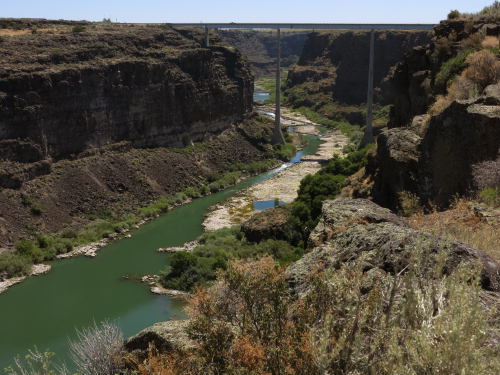
Then I looked down the canyon, and that view was also dramatic: the canyon became broader, and the river divided into several streams, flowing around islands in the middle of which were buttes, the green of the riparian corridor making a strong contrast with the harsh black cliffs of the canyon walls. I walked around for three quarters of an hour, entranced by the view down into the canyon.
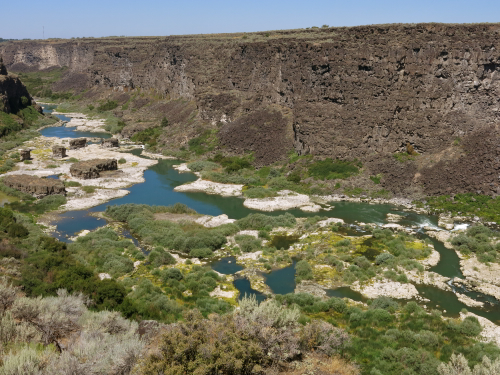
At last I drove on to Shoshone Falls. There isn’t enough water in the summer to make the falls truly dramatic, but they were dramatic enough. I was almost more interested in watching the tourists watch the falls, than in watching the falls themselves. I thought about walking up the trail to where Evel Kneivel jumped his motorcycle across the canyon, but instead drove up to Dierke’s Lake, which lies in a large flat bench partway down the canyon. The swimming area was swarming with people, including lots of children; it was a friendly, homey scene. I walked up past the swimming area and wound up talking with a man from San Jose who was taking his daughter to tour colleges.
From there, I drove on, stopping briefly in Jackpot, Nevada, where I chatted with the cashier at the grocery store where I bought my lunch-time caffeine; she said Jackpot was the kind of small town where you knew everyone, though she admitted that winters could be kind of long. I ate my lunch at a highway rest area by the side of a stream. Of the three picnic tables in the rest area, two were occupied by single men who appeared to have a lot of possessions with them; one of them had a friendly chat with the workers who stopped to empty the trash cans and restock toilet paper at the pit toilets. I assumed these two men lived in or around that remote rest area.
In Wells, Nevada, I stopped at the Emigrant Trail Center, and talked with the volunteer who was staffing it today. He had grown up in Wells, which began as a railroad town — his parents worked for the railroad — and when the railroad reduced its operations in the late 1960s, jobs shifted to supporting the new interstate highway that came through town. The ranchers in the area, he said, also contributed a good deal to the local economy. After the earthquake of 2008, which destroyed many of the old historic brick buildings in the town, a vein of gold was discovered, and plans are now being made to mine that vein — which, he hoped, would add more jobs to the local economy. On my way out of town, I stopped to take a picture of the Community Presbyterian Church, which — so said my friend who grew up in Wells — had stood for more than a century, pretty much unchanged.
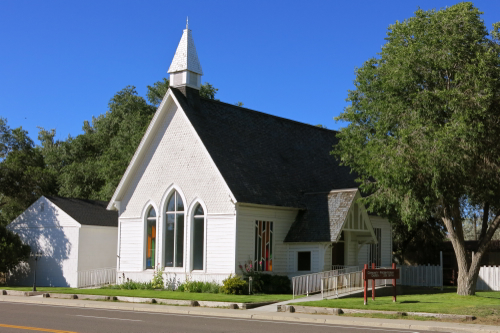
Only one more day to vacation. I’m looking forward to getting back to see Carol. I’m even looking forward to getting back to work — but even so I wish this trip were not going to be over so soon.
At night, I dreamed a great many dreams, but when I was finally awake I remembered none of them; all I remembered was pieces of them: someone needing a pad of paper; children being cared for while their parents did something together; a building with an office that I no longer used. It took me several minutes to come awake, though; I walked around the motel room for a minute or two trying to get re-oriented to the waking world.
Minnesotans have a reputation of being nice, but in the morning I ran into several grim and unhappy people while I bought gas and tried to get some breakfast. Years ago, I took a business trip to Warroad, Minnesota, and in Warroad everyone I met really was nice. But of course not all Minnesotans are nice; Garrison Keillor, with his grim view of human nature, comes to mind. Most of the background music I heard this morning as I did my errands was country music, and I thought that Garrison Keillor was like those lesser country music singers who say they are humble and simple, when they are actually proud of being country, and not at all simple in the way they use their country origins.
Then I realized that all I saw was white people, just as Garrison Keillor’s fictional world is predominantly white. There are too many grim people spinning out fictional worlds that are mostly white. I had been waiting more than five minutes for the grim young waitress to make an appearance, and I left the menu on the table and got in the car and started driving west. As I drove to North Dakota, I sang along to Johnny Cash — “I wear black for the poor and beaten down, living in the hopeless, hungry side of town” — and thought about how this was a song that was on the last CD that my father was able to play for himself on his stereo system before his neurological condition took away his small muscle coordination.
Arrowwood National Wildlife Refuge is about thirty or forty miles from the interstate highway. I drove across the prairie, and down to the refuge headquarters overlooking Arrowwood Lake. One of the rangers pointed out on a map where I might find Sharp-tailed Prairie Grouse: “Here’s where they had their lek,” she said. “It’s a big lek, and there were about fifty males this spring, so there are a lot of birds around. The best time to see them is in the morning or evening.” I told her that I had to leave the refuge before evening. “Well, you’ll just have to walk out on the prairie,” she said, “and see if you flush one out of cover.”
I drove to the place she had indicated on the map, pulled the car over on the narrow dirt road, and walked out onto the prairie. After walking for a while, I turned around and looked back at the car: it looked small and insignificant. Here and there in the prairie were depressions filled with water, and ringed with cattails. Some Common Grackles screamed at me when I got close to one of these prairie potholes.
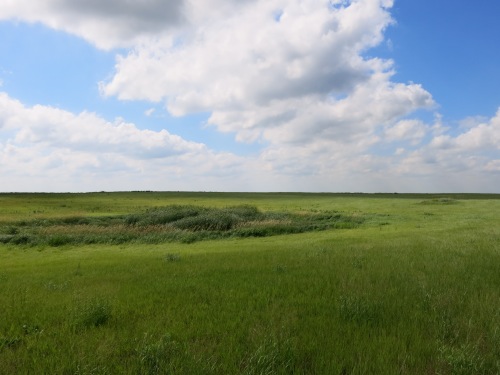
A Savannah Sparrow clung to a milkweed, swaying dangerously in the gusty breeze, singing until one big gust upset him and he flew off. Clouds blew across the sky, leaving patterns of shadow and light on the prairie. I lost track of time. At last I circled back to the road, my trousers marked with dark streaks from some plant, my shoes stained reddish brown in places from having stepped in damp ground, empty of thoughts. It would have been nice to have seen some grouse, but I was satisfied.
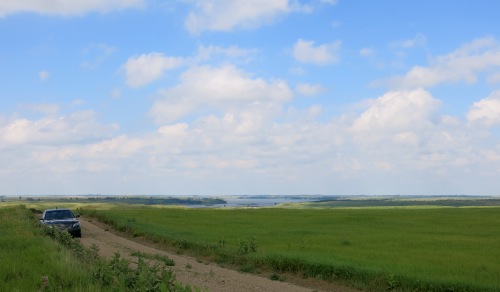
In some tiny North Dakota town I pulled over at a small truck stop to get a sandwich for dinner, and I couldn’t help noticing that about a third of the people there were Hispanic or Asian, not white. The coffee was good, and the sandwich was adequate. I saw my first butte, one of the signs that I was entering the Far West, and then other small formations that weren’t quite buttes, one of which had a giant cow on it.
The clouds grew darker as I drove west, and the wind grew stronger. A few patters of rain on the windshield, and then I saw lightning strike somewhere off to the south. The wind began to blow the car around, and I was glad there were hardly any cars on the road. Ahead of me was one small bit of blue sky. Lightning flashed to the north. Another strong gust of wind, and the headlights showed bits of grass and plants blowing horizontally across the highway. Lightning flashed in the rearview mirror, and in front of me, yet still the road wound towards that one small patch of light sky.*
Gusts of wind hit the car now and then, and I found myself gripping the steering wheel hard. I had to pass a semi-trailer; another car passed me, and I saw that car get blown from one side of the lane to the other. Steady rain for a few minutes, then nothing, then a few drops of rain; and still the road kept winding towards that one calm spot in the sky. At last I pulled into Dickinson. It was almost dark, but it wasn’t raining, and there wasn’t much wind, and that bright spot of sky was directly overhead.
But a half and hour after I checked into the motel, the power went off. Years ago one of our housemates, Judy, had said that you should always carry a flashlight when you stay in a motel, just in case, and so thanks to Judy I had a flashlight. With the lights out, it was time to go to sleep, and some of my last waking thoughts were of my dad in hospice.
Posted a day later and backdated, due to power outage
* “One insurance company reports that farmers had been hurriedly buying hail insurance early Monday to protect the remainder of their crops, which in some instances, has already been severely damaged by storms last week. High winds are expected today [Tuesday, July 28] to follow in the path of severe storms unleashed late Monday, according to the National Weather Service in Bismarck…. Severe weather from Monday night’s storm or high winds could cause farmers to lose the rest of their crops because what’s left is already damaged, according to [Wade] Haselau [of Cottingham Insurance]. ‘Some of the farmers lost what they had left,’ Haselau said. ‘There’s no coming back from this. They’re a whole year away from getting income again.'” — Bismarck [N.D.] Tribune, Tuesday, July 28, 2015, page one.
Vivid dreams occupied me all night, though I didn’t remember any of them when I awakened in the morning. Perhaps they were anxiety dreams, or dreams of overwork; with Peace Camp and the youth service trip and my ordinary tasks, I worked pretty much seven days a week in the three weeks leading up to vacation.
We got up late, and after I ate breakfast we walked over to the Needles Point Pharmacy. I needed razors, and Carol needed a needle to sew up a shirt.
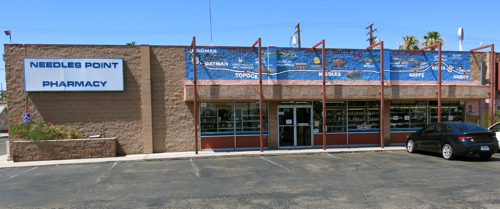
Above: Needles, Calif.
The store was pretty big on the inside. I found the razor blades I wanted, and then Carol and I wandered around looking at everything they had. They seemed to have everything. In addition to the usual drugstore merchandise, they had in stock: jigsaw puzzles, Hummel figurines, 3.5 inch diskettes for your computer, writing tablets with air mail paper, a bright red Mickey Mouse travel alarm clock in yellowed plastic packaging, and brand new Clairol blow dryers dating from the 1980s. On a whim, I bought some air mail paper from the very pleasant woman behind the counter.
When we finally started driving, the thermometer outside the motel office read 110 degrees.
Carol drove for most of the day, while I dozed, and read aloud to her from Agatha Christie’s Murder at Hazelmoor. It seemed odd to be reading about a murder in country house in England in the middle of a dark snowy winter, when we were driving through the wide open, sun-filled southwest.
We stopped for some caffeine at a gas station in Navajo, Arizona. While I was in the gas station, Carol wandered over to where a man was selling jewelry that he had made. When i got there, Carol was trying to decide if she liked one of his necklaces. I got to talking with him. He had been born in the area, half Navajo and half Hopi, and he spoke both languages as birth tongues. Then he had been relocated to a Mormon couple in Utah; enlisted in the Army and served in Vietnam; went to college in Provo on the G.I. Bill; and then had lived in Greece, the Bay area, and several other places I have now forgotten.
He was a big supporter of Barack Obama. “He’s the only president who has done anything for Native Americans,” he said. We agreed that, regardless of his merits, that some of the criticism of Obama was due solely to the fact that he wasn’t white. “White people really like to be right,” he said, and I gave a snort of laughter at the truth of that statement. That got us into a discussion of race and racism, during which I insisted that the Boston area, where I grew up, was the most racist place I have ever lived. “Even the white people hate each other in Boston,” I said, thinking of the Yankees, Irish, Italians, and French Canadians. He agreed with me, though I wasn’t convinced he knew anything about Boston.
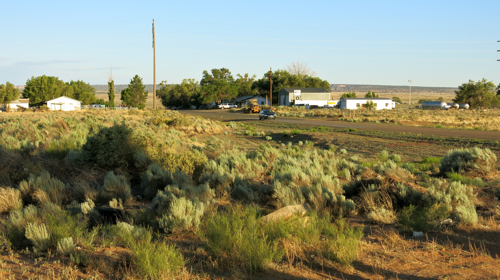
Above: Navajo, Ariz.
Once we left Joliet, it wasn’t far to the outer edge of Chicagoland, that vast sprawling patchwork of suburbia and small cities that extends outward an hour’s drive from Chicago itself. And once we got past Joliet, it felt like we left behind the hustle and bustle and density of the eastern third of the United States: traffic got lighter, the distance between cities became greater, it seemed as though I could feel the density of human beings grow less.
We crossed the Fox River. We used to live near the banks of the Fox River, quite a ways upstream from where we crossed it, ten blocks from the little 1842 stone church building, built of stone hauled up from the river bed in part by the minister, Augustus Conant, the second oldest Unitarian church building still standing west of the Alleghenies.
The miles rolled by. We drove through the barely rolling fields of central Illinois, past the Quad Cities, into the gently rolling land of Iowa, driving almost due west. As we drove, I thought about the dream I had had last night:
Have you climbed up the tower? All the way to the top six levels? someone said to me.
No.
They implied the climb would be spiritually rewarding. So I started to climb.
The first six levels I had already gone up and down: prosaic open-mesh iron staircases of the kind you find in old industrial plants, winding up through a rusted iron structure. Then the staircase from the sixth to the seventh level got very steep, and was behind an iron gate that creaked open.
Then I got into the seventh level. This was the children’s level. A woman I had known in high school sat talking with some children. Bright walls, interesting toys. I moved some mannequins or puppets or dolls made out of wire, to get at the moveable stair case that would get me to the next level.
The eighth level was the map level: it was a balcony around the children’s level, with maps in big wide chart drawers, with big windows above the drawers to look out at the sun setting over the city and landscape beyond….
It was at this point in the dream that the horrendously loud fire alarm went off in the motel. We stumbled around, preparing to get out of the building, when the alarm went silent. We went back to bed, and I began to dream again:
…The ninth level was reached by a steep staircase, the level of Eternal Night: galaxies, suns, darkness, whirling around, and it appeared that in the darkness two or three awe-struck people sat, but of that I couldn’t be sure. I did not stay long there, because it seemed to me that it would be easy to stay there forever.
The tenth level was the level of peace, a peace that surpassed understanding, a place to be in peace. One man sat zazen — I looked at him, and thought, a little scornfully, how stereotypical! — this was a place where peace permeated your being without some painful exercise. I did not stay long here, either.
The eleventh level was the library: low bookshelves all around the four walls, under big picture windows with the sun shining in, trees and birds singing. I wanted to spend a long time here.
The twelfth level: a woman on the stairs warned me that the air was thin. I climbed up the next few stairs. The air was indeed thin; ten thousand, maybe fourteen thousand feet above sea level. I had a hard time catching my breath, but it was a stunning view.
Thinking about such trivial things can occupy the mind for many hours while driving. If you chose, I suppose you could interpret this dream as having deep metaphorical meaning; I ignored any supposed meaning, and just enjoyed remembering it. Soon we stopped at the self-proclaimed largest truck stop in the world. While Carol was inside getting something to drink, I watched as truck pulling an incredibly long blade of a wind turbine held up traffic as it slowly maneuvered into the truck stop:
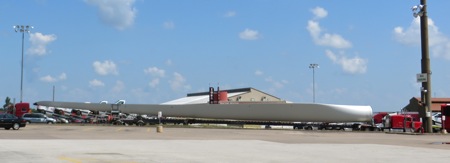
At the western edge of the loess hills of western Iowa, we pulled off at a sign that said “Scenic Viewpoint.” The entrance road wound up a knoll. We parked at the top, and climbed up half a dozen flights of steps made of pressure-treated two-by-twelves supported by telephone poles. At the top, we gazed around us: the broad valley of the Missouri River to the west, and to the north, east, and south, the loess hills rising two or even three hundred feet above the bottom of the valley. The tower swayed slightly in stronger gusts of wind, making me feel a little seasick. We were in a hurry to get to Yankton, to we climbed down and began driving again.
Heading north on Interstate 29, we drove through that broad valley of the Missouri River; through the strong smells of the rendering plants near Sioux City, winding along as we roughly paralleled the invisible river somewhere off to our left. After a time we left the interstate and headed due west, slowing down as we drove through the little college town of Vermilion, South Dakota, speeding up again on the other side until we reached Yankton. We ate dinner with Carol’s aunt, and I got to see pictures of Carol as a baby and a little girl.
For the first time in years, I’m running a fever. It’s been so many years, I’d forgotten what it can be like to have a fever: the way you can feel like you’re not quite in this reality, the hazy thinking, and so on.
It’s not much of a fever, so I’m not getting any fever dreams, which is a little disappointing. I remember having a fever when I was about seven, and hallucinating that a UFO flew by the bedroom window; the UFO looked exactly the rubber stopper we used to plug up the bath tub, so it was obvious that this was not a UFO; nevertheless, I was convinced that I had indeed seen a UFO, and I remained convinced for some years after that. Such are the power of fever dreams.
I can’t help but notice some similarity between fever dreams and mystical experiences: the vague sense of unreality, strange visions, and so on. The difference is that mystical experiences don’t leave you lethargic, thirsty, and unwilling to eat anything; nor are mystical experiences brought under control by taking aspirin.